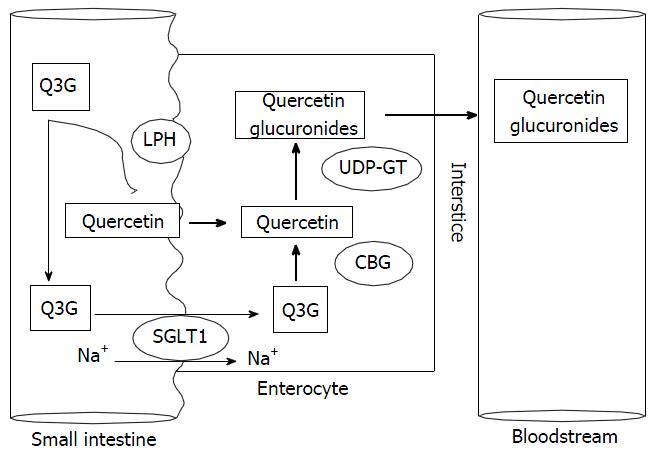Copyright
©The Author(s) 2016.
World J Clin Oncol. Apr 10, 2016; 7(2): 189-199
Published online Apr 10, 2016. doi: 10.5306/wjco.v7.i2.189
Published online Apr 10, 2016. doi: 10.5306/wjco.v7.i2.189
Figure 3 Accepted hypothesis pathway of isoquercitin intestinal absorption.
The most widely accepted hypothesis of isoquercitin intestinal absorption involves lactase phlorizin hydrolase (LPH) as the major step, and sodium-dependent glucose transporter 1 (SGLT1) as a second step. LPH is an extracellular enzyme localized on the outer surface of the small intestinal brush-border membrane. When quercetin-3-glucoside (Q3G) is ingested, it is first hydrolyzed in the small intestine by the lactase domain of LPH, releasing the quercetin aglycone, which then passively diffuses to the enterocity throughout the apical surface. The deglycosylation of Q3G leads to a higher concentration of the aglycone at the apical enterocyte membrane, thereby increasing the rate of absorption. A small amount of Q3G is transported by the SGLT1 present in the apical surface of the small intestine, thereby transporting the intact glycoside into the cell. In enterocytes, cytosolic β-glycosidase (CBG) hydrolyzes the intact Q3G, which is then transported via the SGLT1 route, into the quercetin aglycone. UDP-GT glucuronidates the quercetin aglycone into quercetin glucuronides (conjugated quercetin metabolites and then it finally reaches the bloodstream. UDP-GT: Uridine diphosphate-glucuronosyltransferases.
- Citation: Orfali GDC, Duarte AC, Bonadio V, Martinez NP, de Araújo MEMB, Priviero FBM, Carvalho PO, Priolli DG. Review of anticancer mechanisms of isoquercitin. World J Clin Oncol 2016; 7(2): 189-199
- URL: https://www.wjgnet.com/2218-4333/full/v7/i2/189.htm
- DOI: https://dx.doi.org/10.5306/wjco.v7.i2.189









